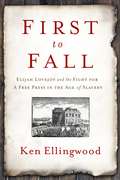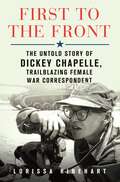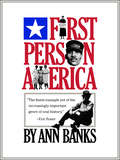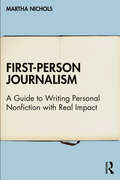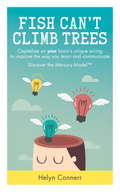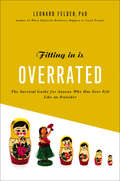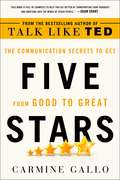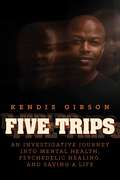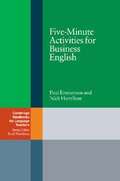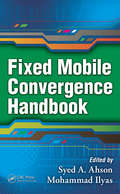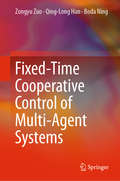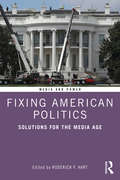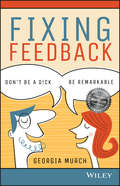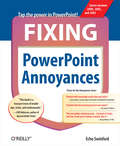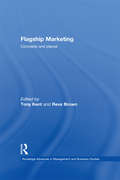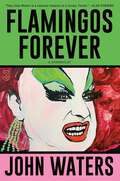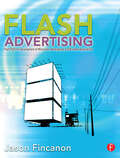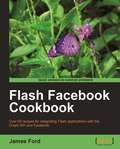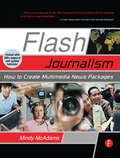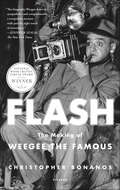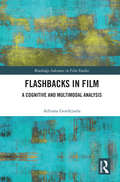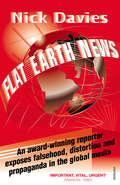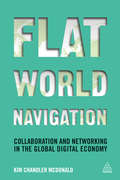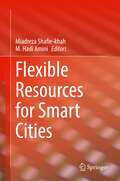- Table View
- List View
First to Fall: Elijah Lovejoy and the Fight for a Free Press in the Age of Slavery
by Ken EllingwoodA vividly told tale of a forgotten American hero—an impassioned newsman who fought for the right to speak out against slavery. The history of the fight for free press has never been more vital in our own time, when journalists are targeted as &“enemies of the people.&” In this bnrilliant and rigorously researched history, award-winning journalist and author Ken Ellingwood animates the life and times of abolitionist newspaper editor Elijah Lovejoy. First to Fall illuminates this flawed yet heroic figure who made the ultimate sacrifice while fighting for free press rights in a time when the First Amendment offered little protection for those who dared to critique America&’s &“peculiar institution.&” Culminating in Lovejoy&’s dramatic clashes with the pro-slavery mob in Alton, Illinois—who were torching printing press after printing press—First to Fall will bring Lovejoy, his supporters and his enemies to life during the raucous 1830s at the edge of slave country. It was a bloody period of innovation, conflict, violent politics, and painful soul-searching over pivotal issues of morality and justice. In the tradition of books like The Arc of Justice, First to Fall elevates a compelling, socially urgent narrative that has never received the attention it deserves. The book will aim to do no less than rescue Lovejoy from the footnotes of history and restore him as a martyr whose death was not only a catalyst for widespread abolitionist action, but also inaugurated the movement toward the free press protections we cherish so dearly today.
First to the Front: The Untold Story of Dickey Chapelle, Trailblazing Female War Correspondent
by Lorissa RinehartThe first authoritative biography of pioneering photojournalist Dickey Chapelle, who from World War II through the early days of Vietnam got her story by any means necessary as one of the first female war correspondents."I side with prisoners against guards, enlisted men against officers, weakness against power."From the beginning of World War II through the early days of Vietnam, groundbreaking female photojournalist and war correspondent Dickey Chapelle chased dangerous assignments her male colleagues wouldn’t touch, pioneering a radical style of reporting that focused on the humanity of the oppressed. She documented conditions across Eastern Europe in the wake of the Second World War. She marched down the Ho Chi Minh Trail with the South Vietnamese Army and across the Sierra Maestra Mountains with Castro. She was the first reporter accredited with the Algerian National Liberation Front, and survived torture in a communist Hungarian prison. She dove out of planes, faked her own kidnapping, and endured the mockery of male associates, before ultimately dying on assignment in Vietnam with the Marines in 1965, the first American female journalist killed while covering combat.Chapelle overcame discrimination both on the battlefield and at home, with much of her work ultimately buried from the public eye—until now. In First to the Front, Lorissa Rinehart uncovers the incredible life and unparalleled achievements of this true pioneer, and the mark she would make on history.
First-Person America
by Ann BanksBetween 1938 and 1942 the Federal Writers' Project set out to create a first-person portrait of America by sending young writers--many of whom later became famous--around the country to interview people from all occupations and backgrounds. This book presents 80 of these diverse life histories, including the stories of a North Carolina patent-medicine pitchman, a retired Oregon prospector, a Bahamian midwife from Florida, a Key West smuggler, recent immigrants to New York, and Chicago jazz musicians. Historian Eric Foner called First-Person America "the finest example yet of an increasingly important genre of oral history."
First-Person Journalism: A Guide to Writing Personal Nonfiction with Real Impact
by Martha NicholsA first-of-its-kind guide for new media times, this book provides practical, step-by-step instructions for writing first-person features, essays, and digital content. Combining journalism techniques with self-exploration and personal storytelling, First-Person Journalism is designed to help writers to develop their personal voice and establish a narrative stance. The book introduces nine elements of first-person journalism—passion, self-reporting, stance, observation, attribution, counterpoints, time travel, the mix, and impact. Two introductory chapters define first-person journalism and its value in building trust with a public now skeptical of traditional news media. The nine practice chapters that follow each focus on one first-person element, presenting a sequence of "voice lessons" with a culminating writing assignment, such as a personal trend story or an open letter. Examples are drawn from diverse nonfiction writers and journalists, including Ta-Nehisi Coates, Joan Didion, Helen Garner, Alex Tizon, and James Baldwin. Together, the book provides a fresh look at the craft of nonfiction, offering much-needed advice on writing with style, authority, and a unique point of view. Written with a knowledge of the rapidly changing digital media environment, First-Person Journalism is a key text for journalism and media students interested in personal nonfiction, as well as for early-career nonfiction writers looking to develop this narrative form.
Fish Can't Climb Trees: Capitalize on your brain's unique wiring to improve the way you learn and communicate. Discover the Mercury Model(TM)
by Helyn ConnerrIn this technological era, with great emphasis placed on sharing information, people are in fact not communicating any better. Despite extraordinary advances in IT devices, social media platforms and Internet access, individuals are still disaffected and relationships are struggling as much as ever. The Mercury Model is an innovative system that addresses this issue. It accepts that each mind is wired differently, and identifies our individual natural master operating programme through its correspondence with the placement of the planet Mercury at the time of our birth. Interpretation, steeped in ancient astrological technique and research, is brought right up-to-date as a 21st century cognitive model. User-friendly graphics portray the concept of handling information in 12 different modes. If we embrace the Mercury Model, we can find common ground between us in order to build authentic, respectful relationships with people of all ages, from all nations, both genders and of all levels of capacity. The Mercury Model supports the position that the world needs all of us - one learning style is not better or worse than another, we all have mental strengths and blind spots; we each do best what comes naturally. The Mercury Model gives permission to be oneself, whether we embody the best characteristics of fish, elephant, penguin or puppy.
Fitting In Is Overrated: The Survival Guide for Anyone Who Has Ever Felt Like an Outsider
by Leonard FelderFrom a psychologist, “practical but insightful coping strategies . . . to build self-awareness and empowerment” around self-acceptance in social situations. (Publishers Weekly)To thine own self be true. But can you do that while still being a valued part of the wider community? Or must you always sacrifice your own inclinations and desires to fit in? For anyone who has ever felt like an outsider at work, in groups, in school, or even in your own extended family, help is on the way. Bestselling author Leonard Felder, PhD, has written the first book with advice on how to be successful personally and professionally when you think differently, live differently, create differently, or solve problems differently than those around you. This wise and perceptive guide is neither about withdrawing into isolation and passivity, nor about spending every waking hour battling with others. Rather, it’s about choosing wisely when to speak your truth and saying it in a way that gets positive results. Dr. Felder shows exactly how creative, thoughtful, unique individuals can survive and thrive in social situations. He provides actual examples from his own practice and precise techniques that will assure your good ideas, outsider perspective, and innovative solutions are respected and taken seriously. Both inspiring and practical, it offers soothing balm and useful answers for everyone who heard too often during adolescence or young adulthood that “you just don’t fit in”—and for the ones who love and counsel them, too. Even more important, it reveals how the very qualities that made you different can become your greatest strengths and most important gifts to the world.
Five Stars: The Communication Secrets to Get from Good to Great
by Carmine Gallo“As technology threatens to displace countless jobs and skills, the ability to communicate is becoming more important than ever. This book is full of examples to help you get better at transporting your thoughts and emotions into the minds of other people.” —Adam Grant, New York Times bestselling author of Give and Take, Originals, and Option B with Sheryl SandbergHow to master the art of persuasion—from the bestselling author of Talk Like TED.Ideas don’t sell themselves. As the forces of globalization, automation, and artificial intelligence combine to disrupt every field, having a good idea isn’t good enough. Mastering the ancient art of persuasion is the key to standing out, getting ahead, and achieving greatness in the modern world. Communication is no longer a “soft” skill—it is the human edge that will make you unstoppable, irresistible, and irreplaceable—earning you that perfect rating, that fifth star.In Five Stars, Carmine Gallo, bestselling author of Talk Like TED, breaks down how to apply Aristotle’s formula of persuasion to inspire contemporary audiences. As the nature of work changes, and technology carries things across the globe in a moment, communication skills become more valuable—not less. Gallo interviews neuroscientists, economists, historians, billionaires, and business leaders of companies like Google, Nike, and Airbnb to show first-hand how they use their words to captivate your imagination and ignite your dreams.In the knowledge age—the information economy—you are only as valuable as your ideas. Five Stars is a book to help you bridge the gap between mediocrity and exceptionality, and gain your competitive edge in the age of automation.In Five Stars, you will also learn: -The one skill billionaire Warren Buffett says will raise your value by 50 percent.-Why your job might fall into a category where 75 percent or more of your income relies on your ability to sell your idea. -How Airbnb’s founders follow a classic 3-part formula shared by successful Hollywood movies.-Why you should speak in third-grade language to persuade adult listeners. -The one brain hack Steve Jobs, Leonardo da Vinci, and Picasso used to unlock their best ideas.
Five Trips: An Investigative Journey into Mental Health, Psychedelic Healing, and Saving a Life
by Kendis GibsonFive Trips chronicles Emmy Award–winning journalist Kendis Gibson&’s personal journey through five psychedelic experiences, exploring the access issues faced by the BIPOC community in using psychedelics for mental health conditions, set against the backdrop of his challenges as a Black journalist at ABC network and the racial treatment that fueled his public meltdowns.Five Trips takes you on a profound journey with Emmy Award–winning journalist Kendis Gibson as he navigates the complex interplay of identity, resilience, and healing. This powerful memoir delves into his personal experiences with psychedelics, examining their transformative impact against the often harsh realities of racial inequity and limited access in the BIPOC community. Gibson&’s candid recounting includes a gripping anxiety attack during a rare interview with Beyoncé, a public confrontation with deeply entrenched racism at ABC, and his private struggle with sexual identity, all woven into the fabric of an illustrious yet tumultuous career in the media. Five Trips is not just a memoir—it&’s a beacon for those seeking to understand the potential of psychedelics in mental health, a testament to overcoming adversity, and an insider&’s perspective on the pivotal moments that shape public figures behind the scenes. Join Kendis Gibson as he reveals the unspoken truths of a life spent in the spotlight, offering insights and hope to those on their own paths to healing.
Five-Minute Activities for Business English
by Penny Ur Paul Emmerson Nick HamiltonThis comprehensive resource book contains an easy-to-use set of short activities essential for anyone teaching Business English. Reflecting real-life business activities such as emails, noisy telephone conversations, making excuses, negotiating, handling customer complaints and cultural awareness, Five-Minute Activities for Business English helps teachers mirror the pacey feel of the work environment. This book is also of interest to teachers of general English who are looking for stimulating skills-based activities in meaningful contexts and complements both tailored and coursebook-based materials. The four main areas covered are 'Business topics', 'Business communication skills', 'Language work' and 'Exploiting coursebooks'. These areas feature activities on various topics such as money, finance, meetings, negotiations, telephoning, management, marketing, etc.
Fixed Mobile Convergence Handbook
by Mohammad Ilyas Syed A. AhsonRequirements for next generation networks (NGNs) are fueling an architectural evolution. Service providers are obliged to give users access to content anytime, anyhow, anywhere, on any device. This requires a converged infrastructure in which users across multiple domains can be served through a single unified domain and all network services and business units can be consolidated on a single IP infrastructure. The Fixed Mobile Convergence Handbook is a comprehensive guide to the design, implementation, and management of converged cellular/WiFi wireless networks. This book discusses how FMC is transforming technologies as multimedia ceases to be passively consumed and unidirectional—and becomes increasingly mobile, personalized and interactive. This book also describes ways to ensure that networks remain cost-effective, scalable, reliable, and secure in the face of constant technological evolution. This material encapsulates the state of FMC, covering everything from basic concepts to research-grade material and future directions. Addressing a broad range of topics, the handbook consists of 16 chapters authored by 44 experts from around the world. Subjects include: Femtocell network technology and applications Deployment modes and interference avoidance Architecture for power efficiency Conversational quality and network planning Design of SIP-based mobility management protocols Highly respected in their field, the authors anticipate the key issues and problems that FMC presents—from application inception and deployment to system interconnection and Quality of Service (QoS). Ideal for professional mobile technology designers and/or planners, researchers (faculty members and graduate students), this book provides specific salient features and information that will guide innovation in the 21st century and beyond. Syed Ahson is a senior software design engineer with Microsoft. Previously, he was a senior staff software engineer with Motorola, where he was a leading contributor in the creation of several iDEN, CDMA, and GSM cellular phones. Dr. Mohammad Ilyas is associate dean for research and industry relations at the College of Engineering and Computer Science at Florida Atlantic University, Boca Raton. A consultant to several national and international organizations, Dr. Ilyas is a member of both the IEEE and ASEE.
Fixed-Time Cooperative Control of Multi-Agent Systems
by Qing-Long Han Zongyu Zuo Boda NingThis monograph presents new theories and methods for fixed-time cooperative control of multi-agent systems. Fundamental concepts of fixed-time stability and stabilization are introduced with insightful understanding. This book presents solutions for several problems of fixed-time cooperative control using systematic design methods. The book compares fixed-time cooperative control with asymptotic cooperative control, demonstrating how the former can achieve better closed-loop performance and disturbance rejection properties. It also discusses the differences from finite-time control, and shows how fixed-time cooperative control can produce the faster rate of convergence and provide an explicit estimate of the settling time independent of initial conditions. This monograph presents multiple applications of fixed-time control schemes, including to distributed optimization of multi-agent systems, making it useful to students, researchers and engineers alike.
Fixing American Politics: Solutions for the Media Age (Media and Power)
by Roderick P. HartFixing American Politics: Solutions for the Media Age brings together original chapters from 34 noted scholars from two disciplines – political science and communication – asked to identify the most pressing problems facing the American people and how they can be solved. Authors address the questions succinctly and directly, with their favored solutions featured in chapter titles that exhort and inspire. The book gives the reader much to think about and debate. Should news outlets be funded with public money rather than by private enterprise? Are the new social media a boon or a bane to political elections? Is the American past dead, or is it living once again? Do churchgoers and environmentalists have anything to discuss? Is the FCC doing its job? Can political ads be made less toxic? Should Fox News be "cancelled?" Should cancel cultures be cancelled? Can we become more civil to one another and, if so, how? Fixing American Politics poses all the best questions … and offers some concrete answers as well. This book is perfect for students, citizens, the media, and anyone concerned with contemporary challenges to civic life and discourse today.
Fixing Feedback
by Georgia MurchFeedback is broken -- here's how to fix it to create a highly engaged workplace with high performing leaders and employees Fixing Feedback is not just another management book -- it's a smart, refreshing, practical guide to feedback in the workplace. Everyone already knows how important feedback is, and we all know we should be giving it and receiving it regularly -- yet we still do it poorly or avoid it entirely. This book shows you how to do it right. You'll learn what exactly constitutes useful feedback, how to deliver it effectively, how to receive it gracefully and how to use it to strengthen yourself, your team and your business. You'll learn critical communication skills that you can put into practice today, and get on track to building a "feedback culture" that results in highly engaged, highly productive employees. The way you communicate dictates how you build relationships and make decisions. It's the difference between being remarkable and being a d!ck. Poor communication is a major force driving feedback into the ground, and it can be extremely costly for the company as a whole. This book shows you how to turn the ship around by making feedback a meaningful -- and welcome -- part of your everyday workflow and overall company culture. Understand "remarkable feedback", and how it changes people and workplaces Self-assess your communication style and gauge the impact it has on others Deliver meaningful feedback using a set of pragmatic tools and techniques Confront the personal issues that prevent you from effectively receiving feedback Learn what organisations need to drive to create a 'feedback culture' When organisations fail to grasp the importance of investing in their people effectively, employees disengage. Building a meaningful feedback culture, on the other hand, makes your organisation a place where people want to work, want to achieve and want to be the best. It's all about effective communication. Fixing Feedback provides no-nonsense guidance toward equipping your people to succeed.
Fixing Feedback: Don't Be A D!ck, Be Remarkable
by Georgia MurchFeedback is broken — here's how to fix it to create a highly engaged workplace with high performing leaders and employees Fixing Feedback is not just another management book — it's a smart, refreshing, practical guide to feedback in the workplace. Everyone already knows how important feedback is, and we all know we should be giving it and receiving it regularly — yet we still do it poorly or avoid it entirely. This book shows you how to do it right. You'll learn what exactly constitutes useful feedback, how to deliver it effectively, how to receive it gracefully and how to use it to strengthen yourself, your team and your business. You'll learn critical communication skills that you can put into practice today, and get on track to building a "feedback culture" that results in highly engaged, highly productive employees. The way you communicate dictates how you build relationships and make decisions. It's the difference between being remarkable and being a d!ck. Poor communication is a major force driving feedback into the ground, and it can be extremely costly for the company as a whole. This book shows you how to turn the ship around by making feedback a meaningful — and welcome — part of your everyday workflow and overall company culture. Understand "remarkable feedback", and how it changes people and workplaces Self-assess your communication style and gauge the impact it has on others Deliver meaningful feedback using a set of pragmatic tools and techniques Confront the personal issues that prevent you from effectively receiving feedback Learn what organisations need to drive to create a 'feedback culture' When organisations fail to grasp the importance of investing in their people effectively, employees disengage. Building a meaningful feedback culture, on the other hand, makes your organisation a place where people want to work, want to achieve and want to be the best. It's all about effective communication. Fixing Feedback provides no-nonsense guidance toward equipping your people to succeed.
Fixing PowerPoint Annoyances: How to Fix the Most Annoying Things About Your Favorite Presentation Program (Annoyances)
by Echo SwinfordIf you're vexed and perplexed by PowerPoint, pick up a copy of Fixing PowerPoint Annoyances . This funny, and often opinionated, guide is chock full of tools and techniques for eliminating all the problems that drive audiences and presenters crazy. There's nothing more discouraging than an unresponsive audience--or worse, one that snickers at your slides. And there's nothing more maddening than technical glitches that turn your carefully planned slide show into a car wreck. Envious when you see other presenters effectively use nifty features that you've never been able to get to work right? Suffer no more! Fixing PowerPoint Annoyances by Microsoft PowerPoint MVP Echo Swinford rides to the rescue. Microsoft PowerPoint is the most popular presentation software on the planet, with an estimated 30 million presentations given each day. So no matter how frustrated you get, you're not about to chuck the program in the Recycle Bin. Fixing PowerPoint Annoyances , presents smart solutions to a variety of all-too-familiar, real-world annoyances. The book is divided into big categories, with annoyances grouped by topic. You can read it cover to cover or simply jump to the chapter or section most relevant to you. Inside its pages you'll learn how to create your own templates, work with multiple masters and slide layouts, and take advantage of various alignment and formatting tools. You'll also learn how to import Excel data; insert graphics, PDF, and Word content; create, edit, and format organization charts and diagrams; use action settings and hyperlinks to jump to other slides; and add sound, video, and other types of multimedia to spark up your presentations. Entertaining and informative, Fixing PowerPoint Annoyances is filled with humorous illustrations and packed with sidebars, tips, and tricks, as well as links to cool resources on the Web.
Flagship Marketing: Concepts and places (Routledge Advances in Management and Business Studies)
by Tony Kent Reva BrownFlagships are the physical apogee of consumerism, places where brand experiences are most defined and interactions with consumers are highly refined. This book marks the first comprehensive study of the concept of the flagship, bringing together a range of scholarly insights from the field, covering issues such as consumerism, areas of consumption and experimental marketing theory and practise. The ways in which flagship projects communicate brand values, both externally and internally, form an important part of this book, and provide new perspectives on late twentieth century commercial and cultural policy and practice. Kent and Brown offer a truly interdisciplinary approach to the concept, offering a variety of perspectives on the debates surrounding flagship function and its role as a place of consumption. Chapters focus on the development of prestigious stores, hotels and arts and cultural centres, as showcases for branded experiences and products and as demonstrations of commercial and public policy. Cases and examples include The Eden Project in the UK, automotive showrooms in Germany, hotels in Dubai and Las Vegas, and Vienna's cultural quarter. Theoretical discussion explores the tensions between costs and profitability, conspicuous consumption and the sustainability of iconic forms. The book enables readers to explore the flagship concept from different perspectives, and while a marketing approach predominates, it provides a disciplinary challenge which will open up new ways of understanding the concept.
Flamingos Forever: A Screenplay
by John WatersOne part of John Waters’ iconic Trash Trilogy, Flamingos Forever is a dark-comedy screenplay about a drag queen trying to retain her title of “Filthiest Person in the World.”Fifteen years after the events of Pink Flamingos, Babs Johnson returns to Baltimore from a life spent largely in bus station lavatories, only to find that she once again has to fight for the right to claim the title of “World’s Filthiest Person.” Her nemesis Connie Marble’s sister, Vera Venninger, and her necrophiliac husband, Wilbur, are in her way. So begins a new battle of filth.This raucous, filthy—and essential!—volume in John Waters’ oeuvre never made it to the screen, so this is readers’ and his legions of fans’ one chance to see how this ghastly and irreverent saga meets its end!
Flash Advertising: Flash Platform Development of Microsites, Advergames and Branded Applications
by Jason FincanonCreate awe-inspiring, mind-blowing Flash ads, microsites, advergames, and branded applications that engage consumers and demonstrate their worth to clients. Creating Flash Advertising delivers the nuts and bolts of the development process from initial design conception to ad completion. You'll learn the best practices for: Mastering the myriad of ad specs, deadlines, quality and version control issues and creating ads that balance campaign goals with design constraints. Preparing and building ads with team and QC standards. Using forms and data in ads without file bloatt. File optimization techniques for swf files 3rd party rich media technologies that transcend the 30k banner. Integrating video into sites and banners. Social media applications. Trafficking and tracking ads for impressions, interactions, clicks, and conversions.Using ActionScript to save development time and implement team standards. Published projects developed with the practices and AS code presented in the book are available on the companion website http://www.flashadbook.com
Flash Facebook Cookbook
by James FordWritten in a cookbook style, this book offers solutions using a recipe-based approach. Each recipe contains step-by-step instructions followed by an analysis of what was done in each task and other useful information. This Cookbook is targeted towards those with at least a basic understanding of the Flash Builder IDE and the Flex framework. No prior knowledge of the Facebook APIs is assumed or required. If you want to start building Flash Facebook apps quickly and effectively this is the book for you.
Flash Journalism: How to Create Multimedia News Packages
by Mindy McAdamsThis book will assist journalists and Flash developers who are working together to bring video, audio, still photos, and animated graphics together into one complete Web-based package.This book is not just another Flash book because it focuses on the need of journalists to tell an accurate story and provide accurate graphics. This book will illustrate how to animate graphics such as maps, illustrations, and diagrams using Flash. It will show journalists how to integrate high-quality photos and audio interviews into a complete news package for the Web.Each lesson in the book is followed by a learning summary so that journalists can review the skills they have acquired along the way. In addition, the book's six case studies will allow readers to study the characteristics of news packages created with Flash by journalists and Web developers at The Washington Post, MSNBC.com, and Canadian and European news organizations.
Flash: The Making of Weegee the Famous
by Christopher BonanosWinner of the National Book Critics Circle AwardThe first comprehensive biography of Weegee—photographer, “psychic,” ultimate New Yorker—from Christopher Bonanos, author of Instant: The Story of Polaroid.Arthur Fellig’s ability to arrive at a crime scene just as the cops did was so uncanny that he renamed himself “Weegee,” claiming that he functioned as a human Ouija board. Weegee documented better than any other photographer the crime, grit, and complex humanity of midcentury New York City. In Flash, we get a portrait not only of the man (both flawed and deeply talented, with generous appetites for publicity, women, and hot pastrami) but also of the fascinating time and place that he occupied.From self-taught immigrant kid to newshound to art-world darling to latter-day caricature—moving from the dangerous streets of New York City to the celebrity culture of Los Angeles and then to Europe for a quixotic late phase of experimental photography and filmmaking—Weegee lived a life just as worthy of documentation as the scenes he captured. With Flash, we have an unprecedented and ultimately moving view of the man now regarded as an innovator and a pioneer, an artist as well as a newsman, whose photographs are among most powerful images of urban existence ever made.
Flashbacks in Film: A Cognitive and Multimodal Analysis (Routledge Advances in Film Studies)
by Adriana GordejuelaFlashbacks in Film examines fi lm fl ashback as a rich multimodal narrative device, analyzing the cognitive underpinnings of fi lm fl ashbacks and the mechanisms that lead viewers to successfully comprehend them. Combining a cognitive fi lm theory approach with the theoretical framework proposed by blending theory, which claims that human beings’ general ability for conceptual integration underlies most of our daily activities, this book argues that fl ashbacks make sense to the viewer, as they are specifi cally designed for the viewer’s cognitive understanding. Through a mixture of analysis and dozens of case studies, this book demonstrates that successful fi lm fl ashbacks appeal to the spectator’s natural perceptual and cognitive abilities, which spectators exercise daily. This book will serve as a valuable resource for scholars interested in film studies, media studies, and cognitive linguistics.
Flat Earth News: An Award-winning Reporter Exposes Falsehood, Distortion and Propaganda in the Global Media
by Nick DaviesDoes ‘fake news’ really exist? Find out from the ultimate insider.After years of working as a respected journalist, Nick Davies, in this shocking exposé, reveals what really goes on behind the scenes of this contentious industry. From a prestigious newspaper that allowed intelligence agencies to plant fiction in its columns, to the newsroom that routinely rejected stories due to racial bias, to the number of papers that accepted cash bribes. Gripping, thought-provoking and revelatory, this is an insider’s look at one of the most tainted professions.‘Meticulous, fair-minded and utterly gripping’ Telegraph‘Powerful and timely...his analysis is fair, meticulously researched and fascinating’ Observer
Flat World Navigation
by Kim Chandler McdonaldFlat World Navigation introduces the new future of work in the 'flattened world' of the new digital attention-based economy, where real connections can be made in seconds across departments, businesses, cultures and countries. Combining the best elements of networking, social media outreach and collaborative techniques, flat world navigation is an essential capability to build and maintain relationships between colleagues, customers and partners. Employees who can transform themselves into flat world navigators, experts in mediating these powerful relationships and bringing the customer into the conversation, will mean the difference between success and failure in business. Flat World Navigation includes exclusive insights and interviews with international business leaders who successfully use flat world navigation skills, such as the Emmy-winning former NBC and Wall Street Journal reporter Kare Anderson, Sandy Carter at IBM, Gordon Feller at CISCO Systems, Aria Finger at DoSomething.org, Louise Guido at ChangeCorp, Jeffrey A. Finkle at the International Economic Development Council and Carolyn Lawrence, CEO of Women of Influence. This book is grounded in real-world experience with insights and advice to build your skills base and empower the next generation of business people. Additionally, it is of great use to business owners and managers looking to effectively leverage the skills of these flat world navigators, whose critical role brings attention to ideas, products and services and, as such, must be part of a successful business strategy.
Flexible Resources for Smart Cities
by M. Hadi Amini Miadreza Shafie-KhahThis book paves the road for researchers from various areas of engineering working in the realm of smart cities to discuss the intersections in these areas when it comes to infrastructure and its flexibility. The authors lay out models, algorithms and frameworks related to the ‘smartness’ in the future smart cities. In particular, manufacturing firms, electric generation, transmission and distribution utilities, hardware and software computer companies, automation and control manufacturing firms, and other industries will be able to use this book to enhance their energy operations, improve their comfort and privacy, as well as to increase the benefit from the electrical system. The book pertains to researchers, professionals, and R&D in an array of industries.
